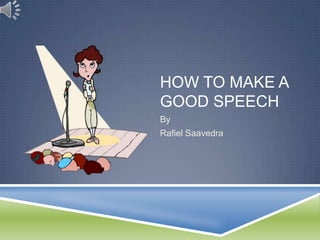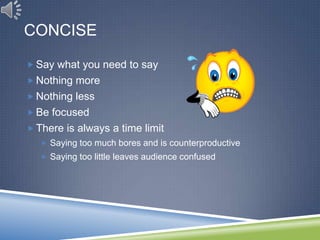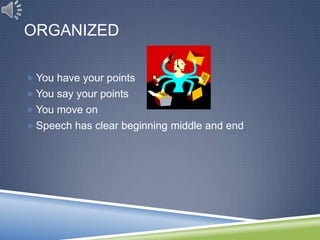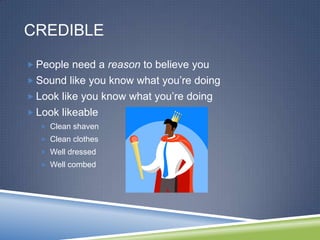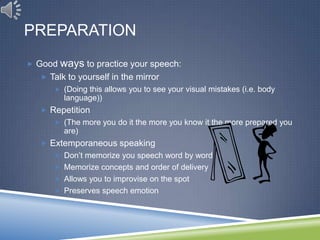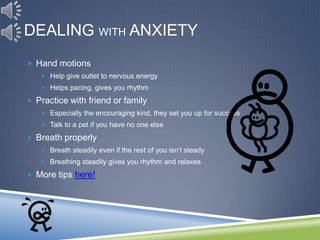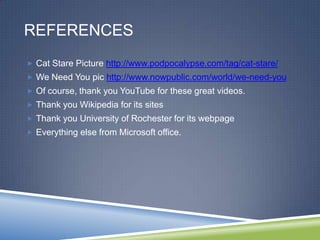RS How to Make a Good Speech
- 1. HOW TO MAKE A GOOD SPEECH By Rafiel Saavedra
- 2. QUALITIES OF A GOOD SPEECH Concise Organized Tailored to Audience Persuasive Credible Proper Delivery
- 3. CONCISE Say what you need to say Nothing more Nothing less Be focused There is always a time limit Saying too much bores and is counterproductive Saying too little leaves audience confused
- 4. ORGANIZED You have your points You say your points You move on Speech has clear beginning middle and end
- 5. AUDIENCE Who are you talking to? Identity of your audience is imperative Are you talking to: elementary school students? college students? business men and woman? union workers? Same speech can be made differently
- 6. PERSUASIVE Appeal to the audience Convince them of your speech Several ways to do this: Humor Evidence based logic Bandwagoning Fearmongering And many many more Wikipedia has several more examples here and here
- 7. CREDIBLE People need a reason to believe you Sound like you know what you’re doing Look like you know what you’re doing Look likeable Clean shaven Clean clothes Well dressed Well combed
- 8. DELIVERY Way you say it is more powerful than how you say it Good hand motions Confident body language Fluent speech Good attitude
- 9. PREPARATION Good ways to practice your speech: Talk to yourself in the mirror (Doing this allows you to see your visual mistakes (i.e. body language)) Repetition (The more you do it the more you know it the more prepared you are) Extemporaneous speaking Don’t memorize you speech word by word Memorize concepts and order of delivery Allows you to improvise on the spot Preserves speech emotion
- 10. DEALING WITH ANXIETY Hand motions Help give outlet to nervous energy Helps pacing, gives you rhythm Practice with friend or family Especially the encouraging kind, they set you up for success Talk to a pet if you have no one else Breath properly Breath steadily even if the rest of you isn’t steady Breathing steadily gives you rhythm and relaxes More tips here!
- 11. VIDEOS!!! Here’s more good advice on good speechmaking http://www.youtube.com/watch?v=ffyEFL7Feag Here’s how NOT to make a speech http://www.youtube.com/watch?v=YivQYeI0vys
- 12. REFERENCES Cat Stare Picture http://www.podpocalypse.com/tag/cat-stare/ We Need You pic http://www.nowpublic.com/world/we-need-you Of course, thank you YouTube for these great videos. Thank you Wikipedia for its sites Thank you University of Rochester for its webpage Everything else from Microsoft office.
